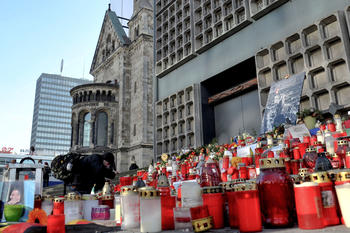Warning Signs of Terror
Psychologist Herbert Scheithauer is studying how young people are radicalized online.
Dec 11, 2018
A moment of silence: On December 19, 2016, terrorist Anis Amri drove a truck into a crowd of people at the Christmas market on Berlin’s Breitscheidplatz. Twelve people were killed, and more than 50 were injured.
Image Credit: Doris Spiekermann-Klaas/Tagesspiegel/picture alliance
Where is the line between a deeply religious Muslim and a radicalized one who is willing to embrace violence? Where does piety end and ideology begin? At what point does a person become willing to leave the path of peaceful dialogue?
And at what point does that person become willing to go beyond that and kill another person for his or her supposed beliefs? Professor Herbert Scheithauer, a psychologist at the Division of Developmental Science and Applied Developmental Psychology at Freie Universität Berlin, is pursuing all of these questions.
Working with scholars and scientists from 14 partner universities in Europe, he initiated the project “Prophets” (Preventing Radicalisation Online through the Proliferation of Harmonised ToolkitS). The goal is to use the next two years to study how young people become radicalized on the Internet and turn into violent criminals. Scheithauer’s team also aims to develop a preventative approach to detect risky developments early on.
“Radical ideas aren’t dangerous at the start,” Scheithauer explains. “We have a lot of people in our society who are devoted to a belief or a political idea and pursue it fervently. But they would never dream of going to their neighbor and saying, I’ll kill you if you don’t adopt my beliefs.” For things to reach that point, a very particular set of circumstances must be present, and the person in question must be vulnerable in very specific ways.
People who commit serious acts of violence have often developed along paths that set them apart from others, Scheithauer says as a developmental psychologist. “We want to find out what those paths look like so that we can better understand how people become radicalized in the future, and perhaps even predict a risk of violence and prevent violent acts.”
Scheithauer says there are many indications that people with a criminal past are more easily persuaded to engage in fanatical violence. They are more receptive to ideologies and notions of violence. The team of researchers aims to reach the goal of the Berlin subproject through several steps. “In the first phase, we want to find out how radicalization develops. To do that, we plan to look at old cases and evaluate them in retrospect.”
Scheithauer plans to conduct interviews with violent criminals in prison and use questionnaires to find out what role online activities played in their radicalization, among other things. “The course taken by radicalization in online media and on social networks like Facebook is especially interesting to us. We want to know things like, how do young people who become radicalized as a result of using certain online media act? How do they present themselves in their Internet profiles? How does their behavior change? How can we see these processes taking place?”
As the next step, Scheithauer’s team plans to prepare a preventative approach: “We want to build expertise in early detection, which we hope will be used in schools in particular.” The approach is modeled on that used for the “Netwass” (Networks Against School Shootings) project, which has already been tested.
That project helps teachers at schools in Germany identify developments that could lead to a crisis among their students. “We hope to build on the project’s results. Various studies have shown that there are parallels between school shooters and violent criminals who commit acts of terror in the name of jihad,” Scheithauer says.
“Our experience with Netwass showed that early identification of developments that could lead to a crisis is effective in terms of prevention. We’ve gotten a lot of positive feedback from schools. Now we want to translate those findings to the new preventative approach.” Scheithauer hopes to prompt schools to engage effectively with at-risk youth. The goal is not to stigmatize students and disparage them as possible perpetrators of violence, but rather to discover developments that could lead to a crisis in time to stop them.
In addition, there should be discussions about values with teens, teachers, and parents alike. Just because a student has a long beard, it does not necessarily have to be a warning sign, Scheithauer says. But if a male student suddenly stops shaking a female teacher’s hand or does not want to sit next to a girl, the teacher should sit up and take notice.
“Even those signals don’t necessarily have to be signs of radicalization and willingness to commit violence,” Scheithauer explains. “There is no clear-cut answer to what symptoms indicate that a young person is becoming radicalized. There are different developmental paths leading to an act. Bullying and a subjective experience of injustice could be one reason, as could shame or humiliation. But those are only some possible clues pointing toward an explanation.”
The frequent hypothesis that those who engage in violent acts have often been the victims of bullying and later acts of violence are a kind of revenge also exists in connection with terrorism, Scheithauer explains. “But the latest studies show that this isn’t always the case, so we don't want to profile people or take suspicious persons into custody simply based on a questionnaire,” he says. “Instead, our goal is to find out when a person is subjectively in crisis and that person’s behavior poses a risk to the community. A sensible prevention program is about offering help, not about prejudice.”
This text originally appeared in German on October 6, 2018, in the Tagesspiegel newspaper supplement published by Freie Universität.

